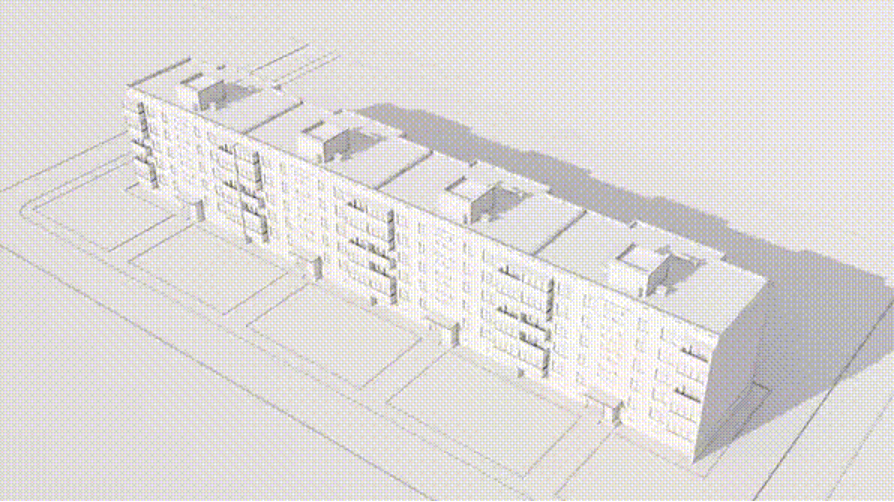Where reconstruction seems never-ending
With a “polycrisis” at large, buildings are being destroyed and damaged and the need for major reconstruction is back. Such a need has never been more urgent since the end of the second world war. The Ukraine invasion has been the most violent example of this over the past six months. Hundreds of heritage sites have already been destroyed, along with infrastructure damage reaching more than $92 billion. Meanwhile, the climate crisis is causing what is known as “climate whiplash“, i.e. a sharp rise in and rapid succession of natural disasters. USAID estimates that recent floods in Pakistan have destroyed or damaged 1.7 million homes. In California, certain residential areas are no longer covered by insurers as wildfires are on the rise. So what does this mean for the construction industry? These findings lead to two major questions: how can we facilitate, optimise and accelerate reconstruction? But also, how can we limit the risk of destruction?
Rebuilding is good. Mitigation is even better
To avoid rebuilding, the best approach is probably to limit the risk of destruction. Enter, mitigation. As a country particularly exposed to seismic and volcanic risks, Chile recently launched 32 urban projects with this in mind, the objective being to limit the impact of future natural disasters. When announcing the plan, Bernardita Paúl, national Head of Disaster Risk Reduction and Reconstruction, explained that “each peso invested in mitigation saves six pesos in reconstruction”. The plan includes creating mitigation parks in flood-prone areas and constructing the country’s first tsunami-resilient buildings. In addition, architects and urban planners are focussing on the role of materials in mitigation approaches. Porous concretes like Aquipor can store some excess water in urban areas. Meanwhile Rain(a)Way has developed pavement slabs that can be used to improve urban water flows, drawing inspiration from the sponge city concept.
Before rebuilding comes emergency housing
When mitigation efforts have not been enough, the initial challenge often lies in managing the emergency. ‘Solidarity’ and ‘DIY’ become the keywords. Railway carriages from Ukraine’s national trains have been converted into emergency housing in Irpin, helping to house locals of the destroyed city. Throughout the country, people are trying as best as they can to seal up some thousands of windows shattered by bombs. As the war still rages on, the emergency forces us to come up with new, lighter and more temporary construction methods. Shortly after the outbreak of conflict and faced with the massive influx of refugees, Ukrainian president Volodymyr Zelensky mandated the firm Balbek Bureau to design a refuge for displaced people. Dubbed Re:Ukraine, the solution is a standardised, modular village capable of providing decent housing in record time. In a similar vein, Christchurch’s “cardboard cathedral” designed by Shigeru Ban is an example of original architecture (it’s partially made from cardboard) made in response to the 2011 earthquake. Designed as a temporary building, it is still actively in use today.
Pictured: Speestac by WZMH Architects
Developed by WZMH Architects, the SPEEDSTAC module aims to rehabilitate partially destroyed but structurally “salvageable” buildings. Designed to avoid the demolition of all buildings affected by the war, SPEEDSTAC comes in the form of pre-built concrete modules specially designed to fit into Soviet architecture.

Starting over with a clean slate
If buildings destroyed by fire or war may seem to give way to a “clean slate”, the reality is more complex. As with any construction project, reconstruction requires preparing the ground – but with new constraints. According to the UN, the city of Irpin alone has 410,000 tonnes of rubble that requires removal. Overall, war brings its share of chemical pollution, cement dust or water contamination. As UN Resident Coordinator in Ukraine, Osnat Lubrani explains, “restoring Ukraine’s environment must be at the top of the agenda”, even above reconstruction.
Innovations in reconstruction
Back in 2019 when a fire had just ravaged Notre-Dame cathedral, Art Graphique et Patrimoine (AGP), a company specialising in 3D surveys of historical monuments, was able to provide a 3D model of the cathedral’s frame as it was before the tragic event took place. The models contain several billion data points, enabling an accuracy of up to one millimetre. The same type of technology is currently being used to scan the ravaged cities of Ukraine. While reconstruction is not directly on the cards, these tools remain invaluable. Not only is it a way of archiving certain buildings at a given moment, the data can also be used in BIM, with a view to reconstruction. For example, in Syria, Reparametrize Studio and Digital Architects used 3D mapping technology to build a powerful tool to aid reconstruction decision-making choices for the city of Damascus.
Between collective therapy and reinvention
Reconstruction also provides an opportunity to take certain societal choices into careful consideration – something of which is of great political importance. In July, a European think tank published A Blueprint for the Reconstruction of Ukraine. Despite the war being far from over, the publication takes the form of an act of resistance. Reconstruction also offers the opportunity to assert certain collective choices. Again in Ukraine, the ReStart Ukraine collective is now inviting people to think about reconstruction according to more sustainable principles. In Nepal, the reconstruction of Shiladevi primary school in Dhoksan following the 2015 earthquake is another fine example. By using only rubble from the disaster, it serves both as a memorial site and as a demonstrator for a more circular vision of construction. A little further back in time, the reconstruction of Warsaw (80% of which was destroyed in the second world war) is emblematic. Behind the rallying cry “The entire nation builds its capital”, the whole population mobilised to remove the ruins, sometimes using 18th century paintings for inspiration! The Polish author Leopold Tyrmand event went so far as to describe that the inhabitants of the capital, who had inhaled large quantities of cement dust during the war, rebuilt the city with their own bodies.
An unusual curiosity: WWII Rebuilder
As a symbol of the power of imagination when it comes to reconstruction, WW2 Rebuilder is a game where you can rebuild cities destroyed by the second world war. Try your hand at various heavy equipment to clear away rubble and persevere in reconstructing destroyed buildings.

